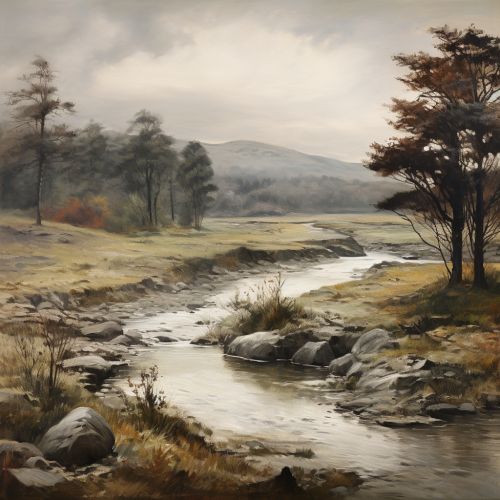Runoff (hydrology)
Overview
Runoff, in the field of hydrology, refers to the flow of water that occurs when excess stormwater, meltwater, or other sources flow over the Earth's surface. This phenomenon is a key part of the water cycle, and is directly related to the capacity of soil to absorb rainfall. The runoff is a major component of the global water circulation, and it is affected by various physical parameters and climatic factors.
Types of Runoff
There are several types of runoff, including surface runoff, groundwater runoff, and subsurface runoff.
Surface Runoff
Surface runoff is precipitation runoff over the landscape. Many factors affect the degree to which rainfall becomes surface runoff, including the rate and duration of precipitation, the soil's infiltration capacity, the relief of the terrain, and the presence or absence of vegetation or other permeable surfaces.
Groundwater Runoff
Groundwater runoff occurs when water infiltrates into the soil and moves laterally through the upper layers of soil until it reaches a stream channel. This type of runoff is also known as baseflow and can contribute a significant portion of a stream's flow in certain areas.
Subsurface Runoff
Subsurface runoff describes the flow of water that infiltrates the soil surface and then moves laterally in the subsurface layer. This can occur when the soil is saturated with water, and any additional rainfall will cause runoff.


Factors Influencing Runoff
Several factors influence the amount and rate of runoff in a particular area. These include the nature of the precipitation (rain, snow, sleet), the characteristics of the watershed (size, shape, slope, soil type, vegetation cover), and human activities (land use, urbanization).
Precipitation
The type, intensity, and duration of precipitation play a significant role in determining the amount of runoff. Heavy or prolonged rainfall can exceed the soil's infiltration capacity, leading to increased runoff. Snowmelt can also contribute to runoff, especially in colder climates.
Watershed Characteristics
The physical characteristics of a watershed can significantly influence runoff. Larger watersheds tend to produce more runoff than smaller ones due to the greater area available for precipitation. The slope of the land can affect the speed at which runoff travels, with steeper slopes generally leading to faster runoff. The type of soil in a watershed can also impact runoff, as some soils (such as clay) are less permeable than others (like sand), leading to more runoff. Similarly, areas with dense vegetation tend to have less runoff as plants slow down the flow of water, allowing more time for infiltration.
Human Activities
Human activities can significantly influence runoff. Urbanization, for example, can increase runoff by creating more impervious surfaces (like roads and buildings) that prevent infiltration of water into the soil. Agricultural practices can also impact runoff, as tilling, planting, and harvesting can alter the soil's structure and permeability.
Runoff Processes
Runoff processes can be classified into three main types: infiltration excess overland flow, saturation excess overland flow, and subsurface storm flow.
Infiltration Excess Overland Flow
Infiltration excess overland flow, also known as Hortonian runoff, occurs when the rate of rainfall exceeds the soil's infiltration capacity. This can happen during intense rainfall events or in areas with low infiltration capacities, such as compacted or frozen soils.
Saturation Excess Overland Flow
Saturation excess overland flow occurs when the soil is saturated with water, and any additional rainfall will cause runoff. This type of runoff is common in humid climates and areas with shallow water tables.
Subsurface Storm Flow
Subsurface storm flow is the movement of water through the soil layer to the stream channel. This process is influenced by the soil's hydraulic conductivity and the depth of the water table.
Runoff Measurement and Estimation
Runoff can be measured directly using stream gauges or indirectly using rainfall data and a runoff coefficient. The runoff coefficient is a dimensionless coefficient relating the amount of runoff to the amount of precipitation received. It is a larger value for areas with high runoff (pavement, steep gradient), and lower for permeable, well vegetated areas (forests, flat land).
Impacts of Runoff
Runoff can have both positive and negative impacts on the environment and human society. On one hand, it is a crucial component of the water cycle, providing essential water resources for ecosystems and human use. On the other hand, excessive runoff can lead to soil erosion, flooding, and water pollution.
Positive Impacts
Runoff plays a vital role in the water cycle, transporting water from the land to the oceans. This process helps to distribute heat around the Earth, influencing climate and weather patterns. Runoff also provides essential water resources for human use, including water for drinking, irrigation, and hydroelectric power.
Negative Impacts
Excessive runoff can lead to a number of environmental problems. These include soil erosion, where runoff carries away the top layer of soil. This can degrade land, reduce agricultural productivity, and lead to the sedimentation of waterways. Runoff can also cause flooding, particularly in urban areas where large amounts of impervious surfaces prevent the infiltration of water. Additionally, runoff can carry pollutants from the land into water bodies, leading to water pollution.
Mitigation and Management of Runoff
There are several strategies for mitigating and managing runoff, including land use planning, green infrastructure, and soil conservation practices.
Land Use Planning
Land use planning can help to manage runoff by controlling the amount and type of development in an area. This can include preserving natural areas, limiting impervious surfaces, and implementing zoning regulations to control development in flood-prone areas.
Green Infrastructure
Green infrastructure refers to the use of natural systems to manage water and provide environmental benefits. This can include features like rain gardens, green roofs, and permeable pavements that can capture and infiltrate runoff.
Soil Conservation
Soil conservation practices can help to reduce runoff by improving the soil's ability to absorb and hold water. This can include practices like contour plowing, terracing, and the use of cover crops.
